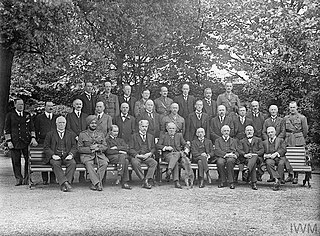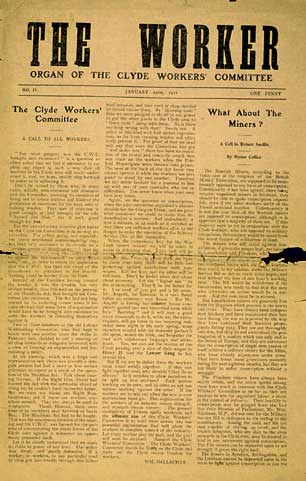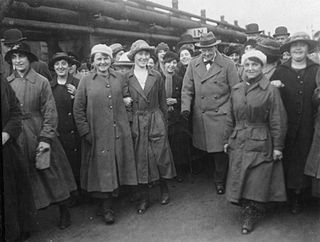
David Lloyd George, 1st Earl Lloyd-George of Dwyfor, was Prime Minister of the United Kingdom from 1916 to 1922. A Liberal Party politician from Wales, he was known for leading the United Kingdom during the First World War, for social-reform policies, for his role in the Paris Peace Conference, and for negotiating the establishment of the Irish Free State. He was the last Liberal Party prime minister; the party fell into third-party status shortly after the end of his premiership.

Herbert Henry Asquith, 1st Earl of Oxford and Asquith,, generally known as H. H. Asquith, was a British politician and statesman who served as Prime Minister of the United Kingdom from 1908 to 1916. He was the last Liberal Party prime minister to command a majority government, and the most recent Liberal to have served as Leader of the Opposition. He played a major role in the design and passage of major liberal legislation and a reduction of the power of the House of Lords. In August 1914, Asquith took Great Britain and the British Empire into the First World War. During 1915, his government was vigorously attacked for a shortage of munitions and the failure of the Gallipoli Campaign. He formed a coalition government with other parties but failed to satisfy critics, was forced to resign in December 1916 and never regained power.

Christopher Addison, 1st Viscount Addison,, was a British medical doctor and politician. A member of the Liberal and Labour parties, he served as Minister of Munitions during the First World War and was later Minister of Health under David Lloyd George and Leader of the House of Lords under Clement Attlee.

The Shell Crisis of 1915 was a shortage of artillery shells on the front lines in the First World War that led to a political crisis in the United Kingdom. Previous military experience led to an over-reliance on shrapnel to attack infantry in the open, which was negated by the resort to trench warfare, for which high-explosive shell were better suited. At the start of the war there was a revolution in doctrine: instead of the idea that artillery was a useful support for infantry attacks, the new doctrine held that heavy guns alone would control the battlefield. Because of the stable lines on the Western Front, it was easy to build railway lines that delivered all the shells the factories could produce. The 'shell scandal' emerged in 1915 because the high rate of fire over a long period was not anticipated and the stock of shells became depleted. The inciting incident was the disastrous Battle of Aubers, which reportedly had been stymied by a lack of shells.

The United Kingdom was a leading Allied Power during the First World War of 1914–1918. They fought against the Central Powers, mainly Germany. The armed forces were greatly expanded and reorganised—the war marked the founding of the Royal Air Force. The highly controversial introduction, in January 1916, of conscription for the first time in British history followed the raising of one of the largest all-volunteer armies in history, known as Kitchener's Army, of more than 2,000,000 men. The outbreak of war was a socially unifying event. Enthusiasm was widespread in 1914, and was similar to that across Europe.

The Asquith coalition ministry was the Government of the United Kingdom under the Liberal prime minister H. H. Asquith from May 1915 to December 1916. It was formed as a multi-party war-time coalition nine months after the beginning of the First World War but collapsed when the Conservative Party withdrew.

Liberal David Lloyd George formed a coalition government in the United Kingdom in December 1916, and was appointed Prime Minister of the United Kingdom by King George V. It replaced the earlier wartime coalition under H. H. Asquith, which had been held responsible for losses during the Great War. Those Liberals who continued to support Asquith served as the Official Opposition. The government continued in power after the end of the war in 1918, though Lloyd George was increasingly reliant on the Conservatives for support. After several scandals including allegations of the sale of honours, the Conservatives withdrew their support after a meeting at the Carlton Club in 1922, and Bonar Law formed a government.

Sir Eric Campbell Geddes was a British businessman and Conservative politician. With a background in railways, he served as head of Military Transportation on the Western Front, with the rank of major-general. He then served as First Lord of the Admiralty between 1917 and 1919. He then served as the first Minister of Transport between 1919 and 1921, in which position he was responsible for the deep public spending cuts known as the "Geddes Axe".

The National Shell Filling Factory, Chilwell, was a World War I United Kingdom Government-owned explosives filling factory. Its formal title was National Filling Factory No. 6. It was located near Chilwell, at that time a village, in Nottinghamshire on the main road from Nottingham to Ashby de la Zouch. During the Great War it filled some 19 million shells with high explosives.

The Imperial Munitions Board (IMB) was the Canadian branch of the British Ministry of Munitions, set up in Canada under the chairmanship of Joseph Wesley Flavelle. It was formed by the British War Cabinet to alleviate the Shell Crisis of 1915 during the First World War. The Board was mandated to arrange for the manufacture of war materials in Canada on behalf of the British government.

The Clyde Workers Committee was formed to campaign against the Munitions Act. It was originally called the Labour Withholding Committee. The leader of the CWC was Willie Gallacher, who was jailed under the Defence of the Realm Act 1914 together with John Muir for an article in the CWC journal The Worker criticising the First World War.

The Munitions of War Act 1915 was a British Act of Parliament passed on 2 July 1915 during the First World War. It was designed to maximize munitions output and brought private companies supplying the armed forces under the tight control of the newly created Ministry of Munitions, under David Lloyd George. The policy, according to J. A. R. Marriott, was that:

Munitionettes were British women employed in munitions factories during the time of the First World War.
Parliamentary Military Secretary Department, No.2 Section (P.M.S.2.), was developed from the Ministry of Munitions Labour Intelligence Division, part of British intelligence unit during World War I to protect British manufacturing industry, especially munitions manufacturing, from sabotage. PMS2 was short lived after a scandal in 1917 involving unprofessional agents.
The home front during World War I covers the domestic, economic, social and political histories of countries involved in that conflict. It covers the mobilization of armed forces and war supplies, lives of others, but does not include the military history. For nonmilitary interactions among the major players see diplomatic history of World War I.

The economic history of World War I covers the methods used by the First World War (1914–1918), as well as related postwar issues such as war debts and reparations. It also covers the economic mobilization of labour, industry, and agriculture leading to economic failure. It deals with economic warfare such as the blockade of Germany, and with some issues closely related to the economy, such as military issues of transportation. For a broader perspective see home front during World War I.
National Filling Factory, Banbury, officially called National Filling Factory No. 9. was a British Ministry of Munitions filling factory, constructed during World War I and located in Banbury, Oxfordshire. The production of filled shells began in April 1916 and ended when the factory closed in 1924

The National Filling Factory, Georgetown, was a First World War munitions factory situated near Houston in Renfrewshire, Scotland. It is believed that the Ministry of Munitions owned up to 12 filling factories; Georgetown was known as NFF.4.

This is a timeline of the British home front during the First World War from 1914 to 1918. This conflict was the first modern example of total war in the United Kingdom; innovations included the mobilisation of the workforce, including many women, for munitions production, conscription and rationing. Civilians were subjected to naval bombardments, strategic bombing and food shortages caused by a submarine blockade.
The Munitions Inventions Department (MID) of the British Ministry of Munitions was created during the First World War in 1915. Its administrative structure encompassed university and industrial laboratories, private workshops, and military experimental grounds. The department made us of the experimental facilities of other government agencies, including the National Physical Laboratory at Bushy House and the Department of Scientific and Industrial Research (DSIR). Two sister organisations were formed: The Board of Invention and Research (BIR) which was established in July 1915 to support the Admiralty, and the Air Inventions Committee (AIC), which supported the Air Board once it became become fully operational in the summer of 1917.
















